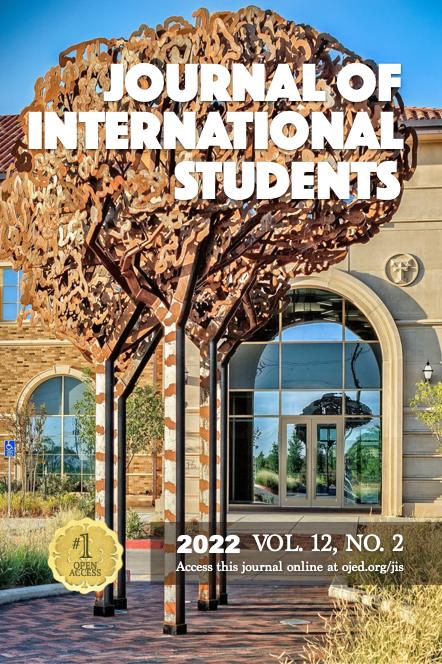Adventures into the Unknown
Exploring the Lived Experience of East Asian International Students as Foreign Accented Speakers in Australian Higher Education
Keywords:
East Asian students, foreign accent, communication barriers, accent discrimination, phenomenologyAbstract
Second language (L2) international students are frequently blamed for miscommunication and even stigmatized and marginalized due to the way they sound. However, little is known about how their accent contributes to the L2 lived experience at foreign universities. Taking a mixed methods phenomenological approach, survey (N = 306) and semi-structured interviews with participants from East Asian countries (N = 5), this study reveals that their personal journey as foreign-accented speakers can be traced through a four-stage process: (a) surprise, (b) anticlimax, (c) learning to survive, and (d) feeling empowered. The first two themes are a period wherein participants experience high levels of stress and anxiety because of having to fit into new learning environments. The last two themes refer to a stage where they developed the ability to survive with increasing self-confidence. Practical implications for improving the campus climate for all L2 students are discussed.
References
Australian Government. (2020). International student enrolments in Australia 1994–2019. International Education. https://internationaleducation.gov.au/research/International-Student-Data/Documents/INTERNATIONAL%20STUDENT%20DATA/2019/2019%20Time%20Series%20Graph.pdf
Bourdieu, P. (1977). The economics of linguistic exchanges. Social Science Information, 16(6), 645-668. https://doi.org/10.1177/053901847701600601
Bourdieu, P. (1992). Language and symbolic power. Polity Press.
Cohen, L., Manion, L., & Morrison, K. (2018). Research methods in education (8th ed.). Routledge.
Derwing, T., & Munro, M. (2009). Putting accent in its place: Rethinking obstacles to communication. Language Teaching, 42(4), 476-490. https://doi.org/10.1017/S026144480800551X
Dooey, P. (2010). Students' perspectives of an EAP pathway program. Journal of English for Academic Purposes, 9(3), 184-197. https://doi.org/10.1016/j.jeap.2010.02.013
Hellstén, M., & Prescott, A. (2004). Learning at university: The international student experience. International Education Journal, 5(3), 344-351.
Houshmand, S., Spanierman, L. B., & Tafarodi, R. W. (2014). Excluded and avoided: Racial microaggressions targeting Asian international students in Canada. Cultural Diversity & Ethnic Minority Psychology, 20(3), 377-388. https://doi.org/10.1037/a0035404
Hunley, H. A. (2010). Students’ functioning while studying abroad: The impact of psychological distress and loneliness. International Journal of Intercultural Relations, 34(4), 386-392. https://doi.org/10.1016/j.ijintrel.2009.08.005
Jean-Francois, E. (2019). Exploring the perceptions of campus climate and integration strategies used by international students in a US university campus. Studies in Higher Education, 44(6), 1069-1085. https://doi.org/10.1080/03075079.2017.1416461
Jenkins, J. (2000). The phonology of English as an international language. Oxford University Press.
Kettle, M. (2013, September). The right to a voice and the fight to be heard: The experience of being an ESL user in Australia [Paper presentation]. The International Pragmatics Conference (IPrA) 2013: Implicit discrimination in public discourse symposium, New Delhi, India.
Khawaja, N. G., & Stallman, H. M. (2011). Understanding the coping strategies of international students: A qualitative approach. Australian Journal of Guidance and Counselling, 21(2), 203-224. https://doi.org/10.1375/ajgc.21.2.203
Lippi-Green, R. (2012). English with an accent: Language, ideology, and discrimination in the United States (2nd ed.). Routledge.
Miller, J. (2003). Audible difference: ESL and social identity in schools. Multilingual Matters.
Moon, C. Y., Zhang, S., Larke, P. J., & James, M. C. (2020). We are not all the same: A qualitative analysis of the nuanced differences between Chinese and South Korean international graduate students' experiences in the United States. Journal of International Students, 10(1), 28-49. https://doi.org/10.32674/jis.v10i1.770
Newsome, L. K., & Cooper, P. (2016). International students' cultural and social experiences in a British university: "Such a hard life [it] is here". Journal of International Students, 6(1), 195-215.
Author. (2016).
Patkowski, M. S. (1990). Age and accent in a second language: A reply to James Emil Flege. Applied Linguistics, 11(1), 73-89. https://doi.org/10.1093/applin/11.1.73
Ryan, J., & Viete, R. (2009). Respectful interactions: Learning with international students in the English-speaking academy. Teaching in Higher Education, 14(3), 303-314. https://doi.org/10.1080/13562510902898866
Sato, T., & Hodge, S. R. (2009). Asian international doctoral students' experiences at two American universities: Assimilation, accommodation, and resistance. Journal of Diversity in Higher Education, 2(3), 136-148. https://doi.org/10.1037/a0015912
Sawir, E., Marginson, S., Forbes-Mewett, H., Nyland, C., & Ramia, G. (2012). International student security and English language proficiency. Journal of Studies in International Education, 16(5), 434-454. https://doi.org/10.1177/1028315311435418
Taylor, G., & Ali, N. (2017). Learning and living overseas: Exploring factors that influence meaningful learning and assimilation: How international students adjust to studying in the UK from a socio-cultural perspective. Education Sciences, 7(1), 35. https://doi.org/10.3390/educsci7010035
van Manen, M. (2016). Researching lived experience: Human science for an action sensitive pedagogy (2nd ed.). Routledge.
Downloads
Published
Issue
Section
License
Copyright (c) 2022 Journal of International Students

This work is licensed under a Creative Commons Attribution-NonCommercial-NoDerivatives 4.0 International License.
All published articles are licensed under a Creative Commons Attribution-NonCommercial-NoDerivs 4.0 Unported License.















